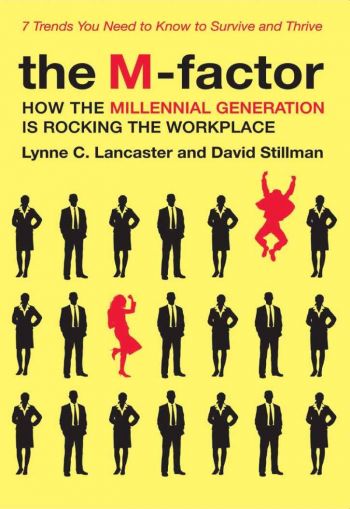The M-Factor: 7 Millennial Markers
Book Review: Understanding what makes the fastest-growing worker group tick
- |
- Written by Tammy Belt
- |
- Comments: DISQUS_COMMENTS
 The M-Factor: How the Millennial Generation Is Rocking The Workplace, by Lynne Lancaster and David Stillman. Harper Collins, 305 pp., 2010
The M-Factor: How the Millennial Generation Is Rocking The Workplace, by Lynne Lancaster and David Stillman. Harper Collins, 305 pp., 2010
We’ve all wondered at one time or another, “What is wrong with the ____________ Generation?”
Each generation has a different way of viewing the world and interacting with it. The M-Factor, by authors Lynne Lancaster and David Stillman, focuses on the Millennial generation. Millennials, as the authors define the generation, were born between 1982 and 2000. They are 76 million strong and represent the fastest-growing segment of today’s workforce.
And for some employers, one of the most challenging.
Makings of a generation
In researching this book, the authors completed a survey of 1,600. The survey contained a representative sampling of all four generations, across all four regions of the United States, plus with 20% of the responses coming from outside the US. There was a mix of ethnicities and a representation of a wide variety of industries, as well as the public sector and education.
According to the authors, there are seven trends that make up the “M-Factor.” The authors explain each trend with easy-to-read anecdotes and real-life stories.
There is advice on how to deal with a millennial—as well as advice for the millennial on how to deal with other generations.
The seven trends identified are as follows: parenting, entitlement, meaning, great expectations, the need for speed, social networking, and collaboration. In further detail:
Parenting: Millennials are their parents’ proudest creations and Mom and Dad are staying around longer. To quote the authors, “When you hire a millennial you get three for the price of one—here come Mom and Dad.” One anecdote recounts how the mother of a millennial who received a poor performance review called Human Resources, to complain.
Entitlement: Raised by parents who gave constant praise and feedback to them, the new generation fully expects the same when they arrive at the workplace. They have a lot to offer—and expect a lot in return. The trick is to motivate them without insulting those of other generations who have put in the years and “earned” their positions.
Meaning: Millennials want a job that “means something.” They want to make a difference with what they do. For the employer, the authors state, it is important to show them how their job fits into the big picture.
At United Community Bank we have a committee to oversee funds that have been raised by employee fundraisers, which decides how to distribute the funds, which has been helpful in our adaptation.
The authors also talk about creating a “SWOT” team based on the SWOT analysis process (Strengths, Weaknesses, Opportunities, Threats). UCB actually did this several years ago and received some valuable ideas.
Great Expectations: One of the biggest hurdles between the generations is mismatched expectations. Millennials expect rapid fulfillment and success; other generations expect millennials to work hard, show up on time, and dress for success. The authors used an example of a PowerPoint presentation that a newly employed millennial thought was boring. She volunteered to “tweak” it and added lots of pictures and animations which took away from the serious nature of the presentation.
Clearly, both sides had different expectations.
The Need for Speed: The Millennial generation doesn’t know what it is not to have a computer. They are accustomed to instant access to information. The rub between generations comes with the speed in which millennials expect to accomplish tasks. Is faster always better?
Social Networking: Social networking—Facebook, Twitter, and more—often blurs the line between personal and professional information. It is a powerful tool when used responsibly. The authors ask the reader to consider social networking as a new form of team building.
Collaboration: The authors point out that millennials have always been given the floor to express their opinions. They expect the same at work. If you want to enhance their work experience, they suggest, place them in groups to work on projects.
Overall message of M-Factor
The most important message of the book is the authors’ stress that there is no generation that is right or wrong in their approach to work, they’re just different. Therein lies great opportunity.
Now that you’ve finished this review, read Millennials’ Priorities: Mobile And Paperless
Want more banking news and analysis?
Get banking news, insights and solutions delivered to your inbox each week.
Tagged under Books for Bankers,













